Related Research Articles

The Warsaw Ghetto was the largest of the Nazi ghettos during World War II and the Holocaust. It was established in November 1940 by the German authorities within the new General Government territory of occupied Poland. At its height, as many as 460,000 Jews were imprisoned there, in an area of 3.4 km2 (1.3 sq mi), with an average of 9.2 persons per room, barely subsisting on meager food rations. Jews were deported from the Warsaw Ghetto to Nazi concentration camps and mass-killing centers. In the summer of 1942, at least 254,000 ghetto residents were sent to the Treblinka extermination camp during Großaktion Warschau under the guise of "resettlement in the East" over the course of the summer. The ghetto was demolished by the Germans in May 1943 after the Warsaw Ghetto Uprising had temporarily halted the deportations. The total death toll among the prisoners of the ghetto is estimated to be at least 300,000 killed by bullet or gas, combined with 92,000 victims of starvation and related diseases, the Warsaw Ghetto Uprising, and the casualties of the final destruction of the ghetto.

Shoah is a 1985 French documentary film about the Holocaust, directed by Claude Lanzmann. Over nine hours long and 11 years in the making, the film presents Lanzmann's interviews with survivors, witnesses and perpetrators during visits to German Holocaust sites across Poland, including extermination camps.
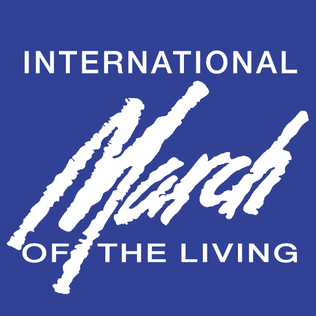
The March of the Living is an annual educational program which brings students from around the world to Poland, where they explore the remnants of the Holocaust. On Holocaust Memorial Day observed in the Jewish calendar, thousands of participants march silently from Auschwitz to Birkenau.

Beginning with the invasion of Poland during World War II, the Nazi regime set up ghettos across German-occupied Eastern Europe in order to segregate and confine Jews, and sometimes Romani people, into small sections of towns and cities furthering their exploitation. In German documents, and signage at ghetto entrances, the Nazis usually referred to them as Jüdischer Wohnbezirk or Wohngebiet der Juden, both of which translate as the Jewish Quarter. There were several distinct types including open ghettos, closed ghettos, work, transit, and destruction ghettos, as defined by the Holocaust historians. In a number of cases, they were the place of Jewish underground resistance against the German occupation, known collectively as the ghetto uprisings.

Tarłów is a village in Opatów County, Świętokrzyskie Voivodeship, in south-central Poland. It is the seat of the gmina called Gmina Tarłów. It lies approximately 30 kilometres (19 mi) north-east of Opatów and 79 km (49 mi) east of the regional capital Kielce. It is approximately 13 kilometres (8 mi) north of the town of Ozarow. The village belongs to historic province of Lesser Poland.

The Grossaktion Warsaw was the Nazi code name for the deportation and mass murder of Jews from the Warsaw Ghetto during the summer of 1942, beginning on 22 July. During the Grossaktion, Jews were terrorized in daily round-ups, marched through the ghetto, and assembled at the Umschlagplatz station square for what was called in the Nazi euphemistic jargon "resettlement to the East". From there, they were sent aboard overcrowded Holocaust trains to the extermination camp in Treblinka.

Alfreda and Bolesław Pietraszek were a Polish husband and wife who sheltered several Jewish families consisting of 18 people during the Nazi German occupation of Poland in World War II. They were posthumously bestowed the titles of Righteous Among the Nations by Yad Vashem in September 2007. The medals and the diploma were presented by the Israeli vice-ambassador in Poland, Yossef Levy, to their two surviving cousins, Zofia Panfil and Jolanta Okulicz-Kozaryn from Olsztyn. In his speech, Yossef Levy said. "We have the utmost respect for those who risked their lives to save Jews under the threat of death. The rescued will never forget the rescuers."

Polish Jews were the primary victims of the Nazi Germany-organized Holocaust in Poland. Throughout the German occupation of Poland, Jews were rescued from the Holocaust by Polish people, at risk to their lives and the lives of their families. According to Yad Vashem, Israel's official memorial to the victims of the Holocaust, Poles were, by nationality, the most numerous persons identified as rescuing Jews during the Holocaust. By January 2022, 7,232 people in Poland have been recognized by the State of Israel as Righteous among the Nations.

Jerzy and Irena Krępeć, a Polish husband and wife, living in Gołąbki near Warsaw during Nazi German occupation of Poland in World War II, were the Righteous who rescued Polish Jews with families including refugees from the Ghetto in Warsaw during the Holocaust.

Radom Ghetto was a Nazi ghetto set up in March 1941 in the city of Radom during the Nazi occupation of Poland, for the purpose of persecution and exploitation of Polish Jews. It was closed off from the outside officially in April 1941. A year and a half later, the liquidation of the ghetto began in August 1942, and ended in July 1944, with approximately 30,000–32,000 victims deported aboard Holocaust trains to their deaths at the Treblinka extermination camp.

Samuel Willenberg, nom de guerreIgo, was a Polish Holocaust survivor, artist, and writer. He was a Sonderkommando at the Treblinka extermination camp and participated in the unit's planned revolt in August 1943. While 300 escaped, about 79 were known to survive the war. Willenberg reached Warsaw where, before war's end, he took part in the Warsaw Uprising. At his death, Willenberg was the last survivor of the August 1943 Treblinka prisoners' revolt.

Kalman Taigman also Teigman Hebrew: קלמן טייגמן was an Israeli citizen who was born and grew up in Warsaw, Poland. One of the former members of the Jewish Sonderkommando who escaped from the Treblinka extermination camp during the prisoner uprising of August 1943, Taigman later testified at the 1961 Eichmann Trial held in Jerusalem.
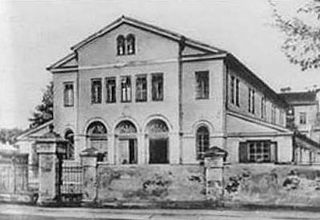
The Siedlce Ghetto, was a World War II Jewish ghetto set up by Nazi Germany in the city of Siedlce in occupied Poland, 92 kilometres (57 mi) east of Warsaw. The ghetto was closed from the outside in early October 1941. Some 12,000 Polish Jews were imprisoned there for the purpose of persecution and exploitation. Conditions were appalling; epidemics of typhus and scarlet fever raged. Beginning 22 August 1942 during the most deadly phase of the Holocaust in occupied Poland, around 10,000 Jews were rounded up – men, women and children – gathered at the Umschlagplatz, and deported to Treblinka extermination camp aboard Holocaust trains. Thousands of Jews were brought in from the ghettos in other cities and towns. In total, at least 17,000 Jews were annihilated in the process of ghetto liquidation. Hundreds of Jews were shot on the spot during the house-to-house searches, along with staff and patients of the Jewish hospital.

Blind Love: A Holocaust Journey Through Poland with Man's Best Friend is a 2015 documentary film about blind Israelis traveling to Poland with the help of their guide dogs, to learn about the Holocaust. Footage includes blind participants taking part in the 2012 and 2013 March of the Living programs. The film is narrated by Michael Enright of the Canadian Broadcasting Corp.

The March of the Living Digital Archive Project, begun in 2013, aims to gather Holocaust testimony from Canadian survivors who have participated in the March of the Living. Since 1988, Holocaust survivors have traveled to Poland with young students on the March of the Living to share their Holocaust stories in the locations they transpired.
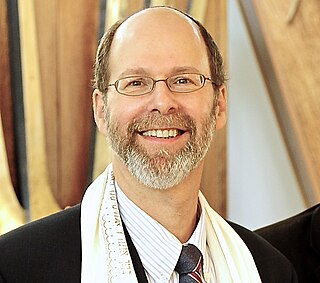
Eli Rubenstein is a Holocaust educator, writer, and filmmaker. He is currently the religious leader of Congregation Habonim Toronto, a Toronto synagogue founded by Holocaust survivors.

Nate Leipciger is a Holocaust educator, public speaker and author.
Max T. Eisen was a Slovak author, public speaker, and Holocaust educator. He travelled throughout Canada giving talks about his experiences as a concentration camp survivor, to students, teachers, universities, law enforcement personnel, and the community at large.
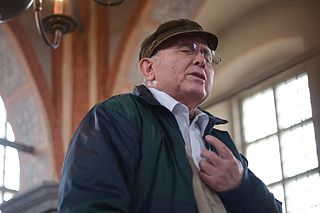
Pinchas Gutter is a Holocaust educator and frequent guest lecturer for the Sarah and Chaim Neuberger Holocaust Centre and the March of the Living and March of Remembrance and Hope programs. He is one of the pioneers of an innovative project called Dimensions in Testimony in which a life-sized interactive biography will be wheeled into classrooms, lecture halls and museums. The idea is that the audience asks questions and pre-recorded statements from the video Gutter will respond – much as if talking to the real person. Gutter has also been the subject of a number of films by directors such as Fern Levitt, Eli Rubenstein, Stephen D. Smith and Zvike Nevo.
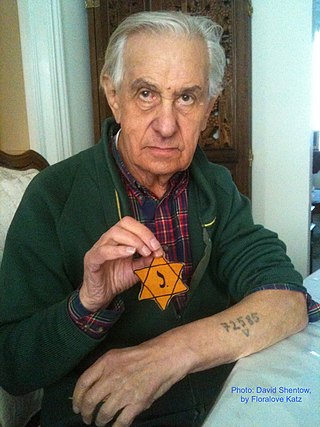
David Shentow was a Belgian-Canadian Holocaust survivor and educator, featured in Canadian films, books and articles. He received the Queen Elizabeth II Diamond Jubilee Medal in 2012, and the Sovereign's Medal for Volunteers in 2017. For "extraordinary community service to the citizens of the City of Ottawa, the Province of Ontario and Canada", the "David Shentow Park" was unveiled by Mayor Jim Watson on 11 September 2022.
References
- ↑ "Sidney Zoltak returns to Poland with Montreal students to revisit horrifying 14-month ordeal". CBC News.ca. Retrieved June 4, 2014.
- ↑ "Sydney Zoltak: Reunions". The March of the Living Archive Project. Retrieved June 4, 2014.
- ↑ "Montreal man reunites with Polish rescuer who saved him from Nazis". CBC News.ca. Retrieved June 4, 2014.
- ↑ "Jewish Film Festival Kicks Off". The Hamilton Spectator. Retrieved December 2, 2011.
- ↑ Nashen, G. J. "Sidney Zoltak's Silent Pledge". Nashen Notes. Retrieved 27 November 2013.
- ↑ Rubenstein, Eli (September 8, 2015). "Witness: Passing the Torch of Holocaust Memory to New Generations". Second Story Press. ISBN 1-927583-66-7.
- http://www.cbc.ca/news/world/montreal-man-reunites-with-polish-rescuer-who-saved-him-from-nazis-1.2662273
- http://www.cija.ca/cjhsd/
- https://www.guernicaeditions.com/title/9781550718072
- http://o.canada.com/news/holocaust-survivors-shameful-that-pier-21-not-displaying-memorial-to-victims-of-voyage-of-the-damned
- https://collections.ushmm.org/search/catalog/pa1143062